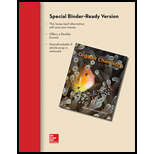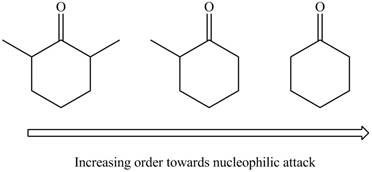
Concept explainers
Rank the following compounds in order of increasing reactivity towards nucleophilic attack.

Interpretation: The given compounds are to be arranged in order of increasing reactivity towards nucleophilic attack.
Concept introduction: Both aldehydes and ketones undergo nucleophilic addition reaction. The relative reactivity of carbonyl group is inversely proportional to the number of
Answer to Problem 21.1P
The arrangement of given compounds in the increasing reactivity towards nucleophilic attack is,

Explanation of Solution
Both aldehydes and ketones undergo nucleophilic addition reaction. In this reaction, the nucleophilic attack takes place at carbonyl carbon. The relative reactivity of carbonyl group is inversely proportional to the number of

Figure 1
The arrangement of given compounds in the increasing reactivity towards nucleophilic attack is shown in Figure 1.
Want to see more full solutions like this?
Chapter 21 Solutions
Organic Chemistry (Looseleaf) - With Access
Additional Science Textbook Solutions
Chemistry: A Molecular Approach
CHEMISTRY-TEXT
Chemistry: Structure and Properties (2nd Edition)
Chemistry: Atoms First
Basic Chemistry (5th Edition)
- Rank the following compounds in order of increasing reactivity in nucleophilic acyl substitution.arrow_forwardRank the compounds in each group in order of increasing reactivity toward nucleophilic attackarrow_forwardRank the following carbonyl compounds in order of increasing reactivity in nucleophilic substitution reactions Please explainarrow_forward
- Rank the following compounds in order of increasing reactivity during an electrophilic substitution reactionarrow_forwardRank the following compounds towards nucleophiles. (1-most reactive - 4- least reactive)arrow_forwardArrange the following carbonyl compounds in INCREASING REACTIVITY towards nucleophilic addition.arrow_forward
- Consider carbonyl compounds A–E drawn below. (a) Rank A–E in order of increasing stability. (b) Rank A–E in order of increasing amount of hydrate formed when treated with aqueous acid. (c) Which compound is most reactive in nucleophilic addition?arrow_forwardRank the following compounds in order of increasing reactivity in a substitution reaction with −CN as nucleophile.arrow_forwardWhat alkyl halide and nucleophile are needed to prepare each compound?arrow_forward

 Organic Chemistry: A Guided InquiryChemistryISBN:9780618974122Author:Andrei StraumanisPublisher:Cengage Learning
Organic Chemistry: A Guided InquiryChemistryISBN:9780618974122Author:Andrei StraumanisPublisher:Cengage Learning

